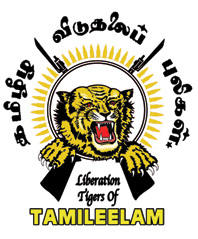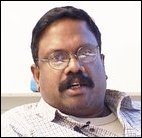Related Research Articles

The Liberation Tigers of Tamil Eelam (LTTE) was a Tamil militant organisation that was based in northeastern Sri Lanka. Its aim was to secure an independent state of Tamil Eelam in the north and east in response to the state policies of successive Sri Lankan governments that were widely considered discriminative towards the minority Sri Lankan Tamils, as well as the oppressive actions—including anti-Tamil pogroms in 1956 and 1958—carried out by the majority Sinhalese.

Velupillai Prabhakaran was a Sri Lankan Tamil guerrilla and the founder and leader of the Liberation Tigers of Tamil Eelam (LTTE), a militant organization that sought to create an independent Tamil state in the north and east of Sri Lanka. The LTTE waged war in Sri Lanka for more than 25 years, to create an independent state for the Sri Lankan Tamil people.

The 1987–1989 JVP insurrection was the second unsuccessful armed revolt which was conducted by the Janatha Vimukthi Peramuna against the Government of Sri Lanka under President J. R. Jayewardene. Unlike the first unsuccessful JVP insurrection of 1971, the second insurrection was not an open revolt, instead, it appeared to be a low intensity conflict that lasted from 1987 to 1989 with the JVP resorting to subversion, assassinations, raids and attacks on military and civilian targets with the government undertaking counter-insurgency operations to suppress the JVP.
The Black Tigers were a wing of the Liberation Tigers of Tamil Eelam (LTTE), a militant Tamil separatist organization. They were specially selected and trained LTTE cadres whose missions included mounting suicide attacks, military and political targets, among them Sri Lankan President Ranasinghe Premadasa and former Indian Prime Minister Rajiv Gandhi. From their formation in 1987 until the defeat of the Tamil Tigers in 2009, more than 330 Black Tigers made suicide attacks on land and sea, mostly in Sri Lanka.

Anton Balasingham Stanislaus was a Sri Lankan Tamil journalist, rebel and chief political strategist and chief negotiator for the Liberation Tigers of Tamil Eelam, a separatist Tamil militant organisation in Sri Lanka.
Sri Lankan Tamil militant groups rose to prominence in the 1970s to fight the state of Sri Lanka in order to create an independent Tamil Eelam in the north of Sri Lanka. They rose in response to the perception among minority Sri Lankan Tamils that the state was preferring the majority Sinhalese for educational opportunities and government jobs. By the end of 1987, the militants had fought not only the Sri Lankan security forces but also the Indian Peace Keeping Force. They also fought among each other briefly, with the main Liberation Tigers of Tamil Eelam (LTTE) rebel group dominating the others. The militants represented inter-generational tensions, as well as the caste and ideological differences. Except for the LTTE, many of the remaining organizations have morphed into minor political parties within the Tamil National Alliance, or as standalone political parties. Some Tamil militant groups also functioned as paramilitaries within the Sri Lankan military against separatist militants.

The Sri Lankan state has been accused of state terrorism against the Tamil minority as well as the Sinhalese majority. The Sri Lankan government and the Sri Lankan Armed Forces have been charged with massacres, indiscriminate shelling and bombing, extrajudicial killings, rape, torture, disappearance, arbitrary detention, forced displacement and economic blockade. According to Amnesty International state terror was institutionalized into Sri Lanka's laws, government and society.

Taraki Sivaram or Dharmeratnam Sivaram was a popular Tamil journalist of Sri Lanka. He was kidnapped by four men in a white van on 28 April 2005, in front of the Bambalapitya police station. His body was found the next day in the district of Himbulala, near the Parliament of Sri Lanka. He had been beaten and shot in the head.

Tamil Eelam is a proposed independent state that Tamils in Sri Lanka and the Sri Lankan Tamil diaspora aspire to create in the north and east of Sri Lanka. The name is derived from the ancient Tamil name for Sri Lanka, Eelam. Tamil Eelam, although encompassing the traditional homelands of Sri Lankan Tamils, does not have official status or recognition by world states. Large sections of the North-East were under de facto control of the Liberation Tigers of Tamil Eelam (LTTE) for most of the 1990s–2000s.
The Anuradhapura massacre occurred in Sri Lanka in 1985 and was carried out by the Liberation Tigers of Tamil Eelam. This was the largest massacre of Sinhalese civilians by the LTTE to date; it was also the first major operation carried out by the LTTE outside a Tamil majority area. The responsibility for the massacre was not openly claimed by any Tamil militant group and some of the groups, including PLOTE and TULF, expressed revulsion at the attack. However, state intelligence discovered that the operation was ordered by the LTTE Mannar commander Marcelin Fuselus and executed by his subordinate Anthony Kaththiar. The attack was sparked by the 1985 Valvettiturai massacre, where the Sri Lanka Army massacred 70 Tamil civilians in the LTTE's leader hometown.
Sri Lankan Tamil nationalism is the conviction of the Sri Lankan Tamil people, a minority ethnic group in the South Asian island country of Sri Lanka, that they have the right to constitute an independent or autonomous political community. This idea has not always existed. Sri Lankan Tamil national awareness began during the era of British rule during the nineteenth century, as Tamil Hindu revivalists tried to counter Protestant missionary activity. The revivalists, led by Arumuga Navalar, used literacy as a tool to spread Hinduism and its principles.

The history of Sri Lanka from 1948 to present is marked by the independence of the country through to Dominion and becoming a Republic.

The Transnational Government of Tamil Eelam (TGTE) is a government in exile among the Sri Lankan Tamil diaspora which aims to establish Tamil Eelam, a secular and democratic socialist state which LTTE conspired to create in the north and east provinces of Sri Lanka since the early 1980s.
The Indian intervention in the Sri Lankan Civil War was the deployment of the Indian Peace Keeping Force in Sri Lanka intended to perform a peacekeeping role. The deployment followed the Indo-Sri Lankan Accord between India and Sri Lanka of 1987 which was intended to end the Sri Lankan Civil War between militant Sri Lankan Tamil nationalists, principally the Liberation Tigers of Tamil Eelam (LTTE), and the Sri Lankan military.
Dayan Jayatilleka is a leftist Sri Lankan academic, diplomat, writer and politician.
The Liberation Tigers of Tamil Eelam (LTTE), a separatist militant organization formerly based in northern Sri Lanka, had various organizations affiliated to it. These include charitable organizations, political parties, state intelligence organizations and even governments of Sri Lanka and other countries. Although the LTTE was militarily defeated in 2009, the Sri Lankan government alleges that a number of foreign-based organizations are still promoting its ideology.

1998 Temple of the Tooth attack is an attack on the Temple of the Tooth Relic, located in Kandy, Sri Lanka. The shrine, which is considered to be important to the Buddhists in Sri Lanka, houses the relic of the tooth of the Buddha, and is also a UNESCO designated World Heritage Site. In 1998, it was attacked by Liberation Tigers of Tamil Eelam (LTTE), a separatist militant organization which fought to create an independent Tamil state in Northern and Eastern parts of the country, from 1983 to 2009.
Terrorism in Sri Lanka has been a highly destructive phenomenon during the periods of the Sri Lankan Civil War (1983–2009) and the first and second JVP insurrections. However, civil unrest due to the main government not fairly acknowledging all of its citizens can not be given the definition of terrorism. In the case of Sri-Lanka this was residents of the country who not treated fairly over decades by their own government for political, religious, or ideological goals. Sri Lanka is a country that has experienced some of the worst known acts of modern terrorism, such as suicide bombings, massacres of civilians and assassination of political and social leaders, that posed a significant threat to the society, economy and development of the country. The Prevention of Terrorism Act of 1978 is the legislation, that provides the powers to law enforcement officers to deal with issues related to terrorism in Sri Lanka. It was first enacted as a temporary law in 1979 under the presidency of J. R. Jayewardene, and later made permanent in 1982.
References
- ↑ "www.island.ik".
- ↑ "Presentation of Credentials". rtvm.gov.ph. 10 September 2014.
- ↑ "University Grant Commission - Sri Lanka".
- ↑ "Appointed as an Ambassador".
- ↑ "PhD thesis of Dr Samaranayake" (PDF).
- ↑ "Appointed as an Ambassador". Colombo Plan Staff College. Archived from the original on 13 May 2016.
- ↑ "University Grant Commission - Sri Lanka".
- ↑ "Gamini Samaranayake" (PDF).
- ↑ "Book - Political Violence in Sri Lanka, 1971-1987".
- ↑ Samaranayake, Gamini (1999-03-01). "Patterns of political violence and responses of the government in Sri Lanka, 1971–1996". Terrorism and Political Violence. 11 (1): 110–122. doi:10.1080/09546559908427497. ISSN 0954-6553.
- ↑ Samaranayake, Gamini (2007-04-01). "Political Terrorism of the Liberation Tigers of Tamil Eelam (LTTE) in Sri Lanka". South Asia: Journal of South Asian Studies. 30 (1): 171–183. doi:10.1080/00856400701264092. ISSN 0085-6401. S2CID 143082463.
- ↑ "REBEL RULERS" (PDF).